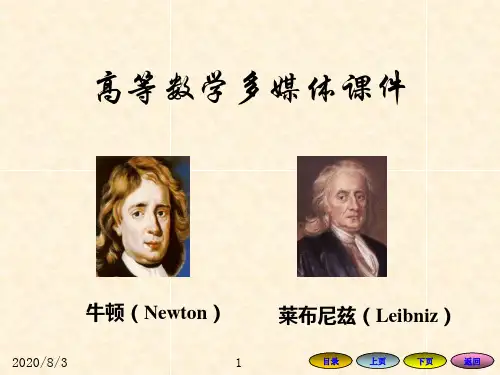高等数学英文版课件PPT 15 Differential equations
- 格式:ppt
- 大小:1.63 MB
- 文档页数:97
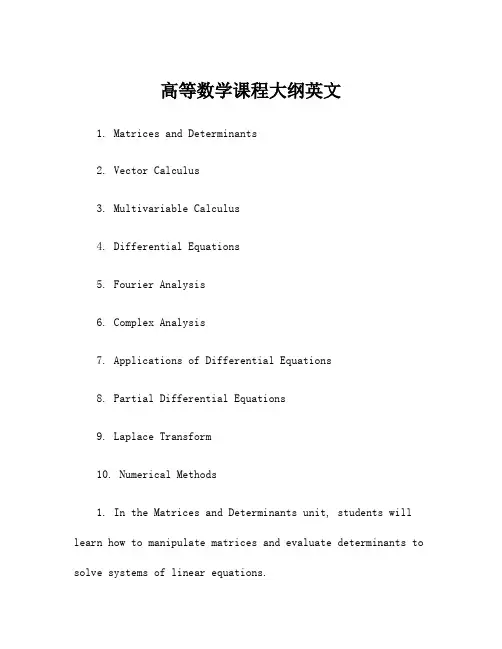
高等数学课程大纲英文1. Matrices and Determinants2. Vector Calculus3. Multivariable Calculus4. Differential Equations5. Fourier Analysis6. Complex Analysis7. Applications of Differential Equations8. Partial Differential Equations9. Laplace Transform10. Numerical Methods1. In the Matrices and Determinants unit, students will learn how to manipulate matrices and evaluate determinants to solve systems of linear equations.(在矩阵和行列式单元中,学生将学习如何操作矩阵和评估行列式以解决线性方程组。
)2. The Vector Calculus unit will cover topics such as the gradient, divergence, and curl of vector fields, as well as line and surface integrals.(向量微积分单元将涵盖向量场的梯度、散度、旋度,以及线性和曲面积分等主题。
)3. The Multivariable Calculus unit will introduce students to functions of several variables, partial derivatives, and the gradient vector.(多元微积分单元将向学生介绍多元函数、偏导数和梯度矢量等概念。
)4. The Differential Equations unit will teach students how to solve differential equations, including first-order linear and nonlinear equations and higher-order linear equations.(微分方程单元将教授学生如何解决微分方程,包括一阶线性和非线性方程以及高阶线性方程。
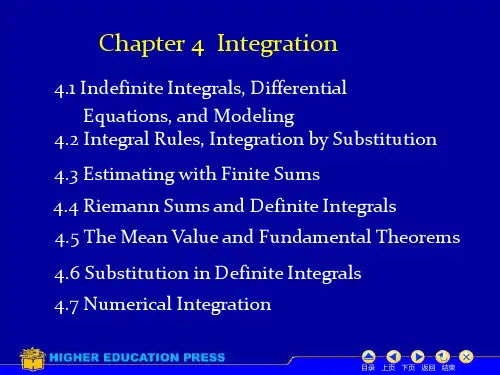
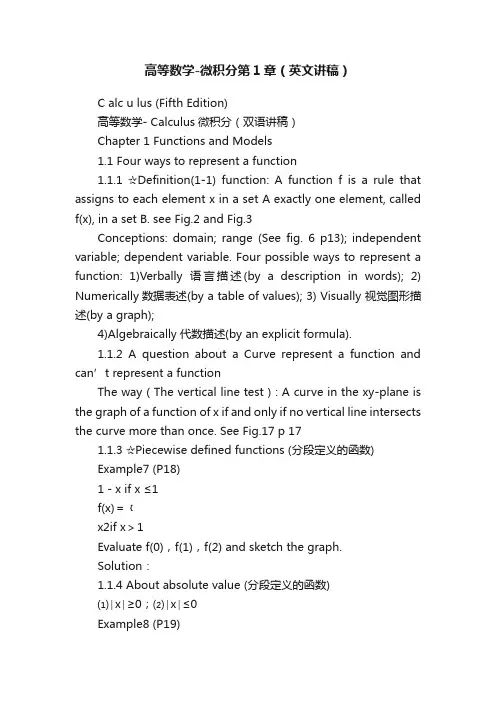
高等数学-微积分第1章(英文讲稿)C alc u lus (Fifth Edition)高等数学- Calculus微积分(双语讲稿)Chapter 1 Functions and Models1.1 Four ways to represent a function1.1.1 ☆Definition(1-1) function: A function f is a rule that assigns to each element x in a set A exactly one element, called f(x), in a set B. see Fig.2 and Fig.3Conceptions: domain; range (See fig. 6 p13); independent variable; dependent variable. Four possible ways to represent a function: 1)Verbally语言描述(by a description in words); 2) Numerically数据表述(by a table of values); 3) Visually 视觉图形描述(by a graph);4)Algebraically 代数描述(by an explicit formula).1.1.2 A question about a Curve represent a function and can’t represent a functionThe way ( The vertical line test ) : A curve in the xy-plane is the graph of a function of x if and only if no vertical line intersects the curve more than once. See Fig.17 p 171.1.3 ☆Piecewise defined functions (分段定义的函数)Example7 (P18)1-x if x ≤1f(x)=﹛x2if x>1Evaluate f(0),f(1),f(2) and sketch the graph.Solution:1.1.4 About absolute value (分段定义的函数)⑴∣x∣≥0;⑵∣x∣≤0Example8 (P19)Sketch the graph of the absolute value function f(x)=∣x∣.Solution:1.1.5☆☆Symmetry ,(对称) Even functions and Odd functions (偶函数和奇函数)⑴Symmetry See Fig.23 and Fig.24⑵①Even functions: If a function f satisfies f(-x)=f(x) for every number x in its domain,then f is call an even function. Example f(x)=x2 is even function because: f(-x)= (-x)2=x2=f(x)②Odd functions: If a function f satisfie s f(-x)=-f(x) for every number x in its domain,thenf is call an odd function. Example f(x)=x3 is even function because: f(-x)=(-x)3=-x3=-f(x)③Neither even nor odd functions:1.1.6☆☆Increasing and decreasing function (增函数和减函数)⑴Definition(1-2) increasing and decreasing function:① A function f is called increasing on an interval I if f(x1)<f(x2) whenever x1<x2 in I. ①A function f is called decreasing on an interval I if f(x1)>f(x2) whenever x1<x2 in I.See Fig.26. and Fig.27. p211.2 Mathematical models: a catalog of essential functions p251.2.1 A mathematical model p25A mathematical model is a mathematical description of a real-world phenomenon such as the size of a population, the demand for a product, the speed of a falling object, the concentration of a product in a chemical reaction, the life expectancy of a person at birth, or the cost of emission reduction.1.2.2 Linear models and Linear function P261.2.3 Polynomial P27A function f is called a polynomial ifP(x) =a n x n+a n-1x n-1+…+a2x2+a1x+a0Where n is a nonnegative integer and the numbers a0,a1,a2,…,a n-1,a n are constants called the coefficients of the polynomial. The domain of any polynomial is R=(-∞,+∞).if the leading coefficient a n≠0, then the degree of the polynomial is n. For example, the function P(x) =5x6+2x5-x4+3x-9⑴Quadratic function example: P(x) =5x2+2x-3 二次函数(方程)⑵Cubic function example: P(x) =6x3+3x2-1 三次函数(方程)1.2.4Power functions幂函数P30A function of the form f(x) =x a,Where a is a constant, is called a power function. We consider several cases:⑴a=n where n is a positive integer ,(n=1,2,3,…,)⑵a=1/n where n is a positive integer,(n=1,2,3,…,) The function f(x) =x1/n⑶a=n-1 the graph of the reciprocal function f(x) =x-1 反比函数1.2.5Rational function有理函数P 32A rational function f is a ratio of two polynomials:f(x)=P(x) /Q(x)1.2.6Algebraic function代数函数P32A function f is called algebraic function if it can be constructed using algebraic operations ( such as addition,subtraction,multiplication,division,and taking roots) starting with polynomials. Any rational function is automatically an algebraic function. Examples: P 321.2.7Trigonometric functions 三角函数P33⑴f(x)=sin x⑵f(x)=cos x⑶f(x)=tan x=sin x / cos x1.2.8Exponential function 指数函数P34The exponential functions are the functions the form f(x) =a x Where the base a is a positive constant.1.2.9Transcendental functions 超越函数P35These are functions that are not a algebraic. The set of transcendental functions includes the trigonometric,inverse trigonometric,exponential,and logarithmic functions,but it also includes a vast number of other functions that have never been named. In Chapter 11 we will study transcendental functions that are defined as sums of infinite series.1.2 Exercises P 35-381.3 New functions from old functions1.3.1 Transformations of functions P38⑴Vertical and Horizontal shifts (See Fig.1 p39)①y=f(x)+c,(c>0)shift the graph of y=f(x) a distance c units upward.②y=f(x)-c,(c>0)shift the graph of y=f(x) a distance c units downward.③y=f(x+c),(c>0)shift the graph of y=f(x) a distance c units to the left.④y=f(x-c),(c>0)shift the graph of y=f(x) a distance c units to the right.⑵ V ertical and Horizontal Stretching and Reflecting (See Fig.2 p39)①y=c f(x),(c>1)stretch the graph of y=f(x) vertically bya factor of c②y=(1/c) f(x),(c>1)compress the graph of y=f(x) vertically by a factor of c③y=f(x/c),(c>1)stretch the graph of y=f(x) horizontally by a factor of c.④y=f(c x),(c>1)compress the graph of y=f(x) horizontally by a factor of c.⑤y=-f(x),reflect the graph of y=f(x) about the x-axis⑥y=f(-x),reflect the graph of y=f(x) about the y-axisExamples1: (See Fig.3 p39)y=f( x) =cos x,y=f( x) =2cos x,y=f( x) =(1/2)cos x,y=f( x) =cos(x/2),y=f( x) =cos2xExamples2: (See Fig.4 p40)Given the graph y=f( x) =( x)1/2,use transformations to graph y=f( x) =( x)1/2-2,y=f( x) =(x-2)1/2,y=f( x) =-( x)1/2,y=f( x) =2 ( x)1/2,y=f( x) =(-x)1/21.3.2 Combinations of functions (代数组合函数)P42Algebra of functions: Two functions (or more) f and g through the way such as add, subtract, multiply and divide to combined a new function called Combination of function.☆Definition(1-2) Combination function: Let f and g be functions with domains A and B. The functions f±g,f g and f /g are defined as follows: (特别注意符号(f±g)( x) 定义的含义)①(f±g)( x)=f(x)±g( x),domain =A∩B②(f g)( x)=f(x) g( x),domain =A∩ B③(f /g)( x)=f(x) /g( x),domain =A∩ B and g( x)≠0Example 6 If f( x) =( x)1/2,and g( x)=(4-x2)1/2,find functions y=f(x)+g( x),y=f(x)-g( x),y=f(x)g( x),and y=f(x) /g( x)Solution: The domain of f( x) =( x)1/2 is [0,+∞),The domain of g( x) =(4-x2)1/2 is interval [-2,2],The intersection of the domains of f(x) and g( x) is[0,+∞)∩[-2,2]=[0,2]Thus,according to the definitions, we have(f+g)( x)=( x)1/2+(4-x2)1/2,domain [0,2](f-g)( x)=( x)1/2-(4-x2)1/2,domain [0,2](f g)( x)=f(x) g( x) =( x)1/2(4-x2)1/2=(4 x-x3)1/2domain [0,2](f /g)( x)=f(x)/g( x)=( x)1/2/(4-x2)1/2=[ x/(4-x2)]1/2 domain [0,2)1.3.3☆☆Composition of functions (复合函数)P45☆Definition(1-3) Composition function: Given two functions f and g the composite func tion f⊙g (also called the composition of f and g ) is defined by(f⊙g)( x)=f( g( x)) (特别注意符号(f⊙g)( x) 定义的含义)The domain of f⊙g is the set of all x in the domain of g such that g(x) is in the domain of f . In other words, (f⊙g)(x) is defined whenever both g(x) and f (g (x)) are defined. See Fig.13 p 44 Example7 If f (g)=( g)1/2 and g(x)=(4-x3)1/2find composite functions f⊙g and g⊙f Solution We have(f⊙g)(x)=f (g (x) ) =( g)1/2=((4-x3)1/2)1/2(g⊙f)(x)=g (f (x) )=(4-x3)1/2=[4-((x)1/2)3]1/2=[4-(x)3/2]1/2Example8 If f (x)=( x)1/2 and g(x)=(2-x)1/2find composite function s①f⊙g ②g⊙f ③f⊙f④g⊙gSolution We have①f⊙g=(f⊙g)(x)=f (g (x) )=f((2-x)1/2)=((2-x)1/2)1/2=(2-x)1/4The domain of (f⊙g)(x) is 2-x≥0 that is x ≤2 {x ︳x ≤2 }=(-∞,2]②g⊙f=(g⊙f)(x)=g (f (x) )=g (( x)1/2 )=(2-( x)1/2)1/2The domain of (g⊙f)(x) is x≥0 and 2-( x)1/2x ≥0 ,that is( x)1/2≤2 ,or x ≤ 4 ,so the domain of g⊙f is the closed interval[0,4]③f⊙f=(f⊙f)(x)=f (f(x) )=f((x)1/2)=((x)1/2)1/2=(x)1/4The domain of (f⊙f)(x) is [0,∞)④g⊙g=(g⊙g)(x)=g (g(x) )=g ((2-x)1/2 )=(2-(2-x)1/2)1/2The domain of (g⊙g)(x) is x-2≥0 and 2-(2-x)1/2≥0 ,that is x ≤2 and x ≥-2,so the domain of g⊙g is the closed interval[-2,2]Notice: g⊙f⊙h=f (g(h(x)))Example9Example10 Given F (x)=cos2( x+9),find functions f,g,and h such that F (x)=f⊙g⊙h Solution Since F (x)=[cos ( x+9)] 2,that is h (x)=x+9 g(x)=cos x f (x)=x2Exercise P 45-481.4 Graphing calculators and computers P481.5 Exponential functions⑴An exponential function is a function of the formf (x)=a x See Fig.3 P56 and Fig.4Exponential functions increasing and decreasing (单调性讨论)⑵Lows of exponents If a and b are positive numbers and x and y are any real numbers. Then1) a x+y=a x a y2) a x-y=a x / a y3) (a x)y=a xy4) (ab)x+y =a x b x⑶about the number e f (x)=e x See Fig. 14,15 P61Some of the formulas of calculus will be greatly simplified if we choose the base a .Exercises P 62-631.6 Inverse functions and logarithms1.6.1 Definition(1-4) one-to-one function: A function f iscalled a one-to-one function if it never takes on the same value twice;that is,f (x1)≠f (x2),whenever x1≠x2( 注解:不同的自变量一定有不同的函数值,不同的自变量有相同的函数值则不是一一对应函数) Example: f (x)=x3is one-to-one function.f (x)=x2 is not one-to-one function, See Fig.2,3,4 ☆☆Definition(1-5) Inverse function:Let f be a one-to-one function with domain A and range B. Then its inverse function f -1(y)has domain B and range A and is defined byf-1(y)=x f (x)=y for any y in Bdomain of f-1=range of frange of f-1=domain of f( 注解:it says : if f maps x into y, then f-1maps y back into x . Caution: If f were not one-to-one function,then f-1 would not be uniquely defined. )Caution: Do not mistake the-1 in f-1for an exponent. Thus f-1(x)=1/ f(x) Because the letter x is traditionally used as the independent variable, so when we concentrate on f-1(y) rather than on f-1(y), we usually reverse the roles of x and y in Definition (1-5) and write as f-1(x)=y f (x)=yWe get the following cancellation equations:f-1( f(x))=x for every x in Af (f-1(x))=x for every x in B See Fig.7 P66Example 4 Find the inverse function of f(x)=x3+6Solution We first writef(x)=y=x3+6Then we solve this equation for x:x3=y-6x=(y-6)1/3Finally, we interchange x and y:y=(x-6)1/3That is, the inverse function is f-1(x)=(x-6)1/3( 注解:The graph of f-1 is obtained by reflecting the graph of f about the line y=x. ) See Fig.9、8 1.6.2 Logarithmic function If a>0 and a≠1,the exponential function f (x)=a x is either increasing or decreasing and so it is one-to-one function by the Horizontal Line Test. It therefore has an inverse function f-1,which is called the logarithmic function with base a and is denoted log a,If we use the formulation of an inverse function given by (See Fig.3 P56)f-1(x)=y f (x)=yThen we havelogx=y a y=xThe logarithmic function log a x=y has domain (0,∞) and range R.Usefully equations:①log a(a x)=x for every x∈R②a log ax=x for every x>01.6.3 ☆Lows of logarithms :If x and y are positive numbers, then①log a(xy)=log a x+log a y②log a(x/y)=log a x-log a y③log a(x)r=r log a x where r is any real number1.6.4 Natural logarithmsNatural logarithm isl og e x=ln x =ythat is①ln x =y e y=x② ln(e x)=x x∈R③e ln x=x x>0 ln e=1Example 8 Solve the equation e5-3x=10Solution We take natural logarithms of both sides of the equation and use ②、③ln (e5-3x)=ln10∴5-3x=ln10x=(5-ln10)/3Example 9 Express ln a+(ln b)/2 as a single logarithm.Solution Using laws of logarithms we have:ln a+(ln b)/2=ln a+ln b1/2=ln(ab1/2)1.6.5 ☆Change of Base formula For any positive number a (a≠1), we havel og a x=ln x/ ln a1.6.6 Inverse trigonometric functions⑴Inverse sine function or Arcsine functionsin-1x=y sin y=x and -π/2≤y≤π / 2,-1≤x≤1 See Fig.18、20 P72Example13 ① sin-1 (1/2) or arcsin(1/2) ② tan(arcsin1/3)Solution①∵sin (π/6)=1/2,π/6 lies between -π/2 and π / 2,∴sin-1 (1/2)=π/6② Let θ=arcsin1/3,so sinθ=1/3tan(arcsin1/3)=tanθ=s inθ/cosθ=(1/3)/(1-s in2θ)1/2=1/(8)1/2Usefully equations:①sin-1(sin x)=x for -π/2≤x≤π / 2②sin (sin-1x)=x for -1≤x≤1⑵Inverse cosine function or Arccosine functioncos-1x=y cos y=x and 0 ≤y≤π,-1≤x≤1 See Fig.21、22 P73Usefully equations:①cos-1(cos x)=x for 0 ≤x≤π②cos (cos-1x)=x for -1≤x≤1⑶Inverse Tangent function or Arctangent functiontan-1x=y tan y=x and -π/2<y<π / 2 ,x∈R See Fig.23 P73、Fig.25 P74Example 14 Simplify the expression cos(ta n-1x).Solution 1 Let y=tan-1 x,Then tan y=x and -π/2<y<π / 2 ,We want find cos y but since tan y is known, it is easier to find sec y first:sec2y=1 +tan2y sec y=(1 +x2 )1/2∴cos(ta n-1x)=cos y =1/ sec y=(1 +x2)-1/2Solution 2∵cos(ta n-1x)=cos y∴cos(ta n-1x)=(1 +x2)-1/2⑷Other Inverse trigonometric functionscsc-1x=y∣x∣≥1csc y=x and y∈(0,π / 2]∪(π,3π / 2]sec-1x=y∣x∣≥1sec y=x and y∈[0,π / 2)∪[π,3π / 2]cot-1x=y x∈R cot y=x and y∈(0,π)Exercises P 74-85Key words and PhrasesCalculus 微积分学Set 集合Variable 变量Domain 定义域Range 值域Arbitrary number 独立变量Independent variable 自变量Dependent variable 因变量Square root 平方根Curve 曲线Interval 区间Interval notation 区间符号Closed interval 闭区间Opened interval 开区间Absolute 绝对值Absolute value 绝对值Symmetry 对称性Represent of a function 函数的表述(描述)Even function 偶函数Odd function 奇函数Increasing Function 增函数Increasing Function 减函数Empirical model 经验模型Essential Function 基本函数Linear function 线性函数Polynomial function 多项式函数Coefficient 系数Degree 阶Quadratic function 二次函数(方程)Cubic function 三次函数(方程)Power functions 幂函数Reciprocal function 反比函数Rational function 有理函数Algebra 代数Algebraic function 代数函数Integer 整数Root function 根式函数(方程)Trigonometric function 三角函数Exponential function 指数函数Inverse function 反函数Logarithm function 对数函数Inverse trigonometric function 反三角函数Natural logarithm function 自然对数函数Chang of base of formula 换底公式Transcendental function 超越函数Transformations of functions 函数的变换Vertical shifts 垂直平移Horizontal shifts 水平平移Stretch 伸张Reflect 反演Combinations of functions 函数的组合Composition of functions 函数的复合Composition function 复合函数Intersection 交集Quotient 商Arithmetic 算数。
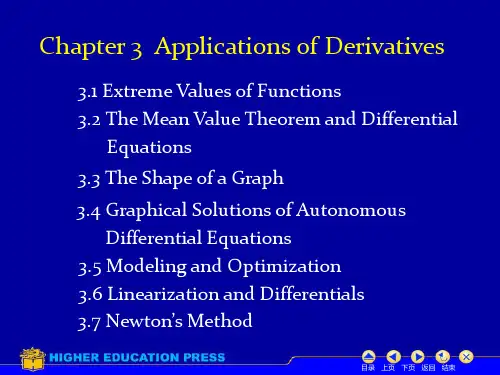
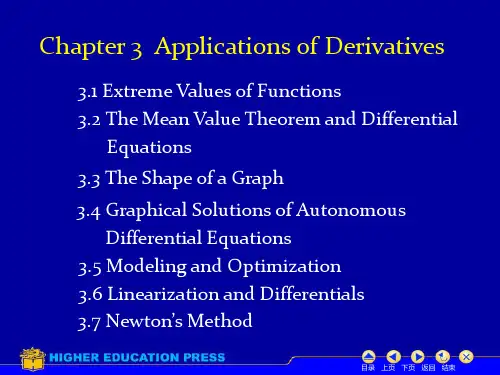

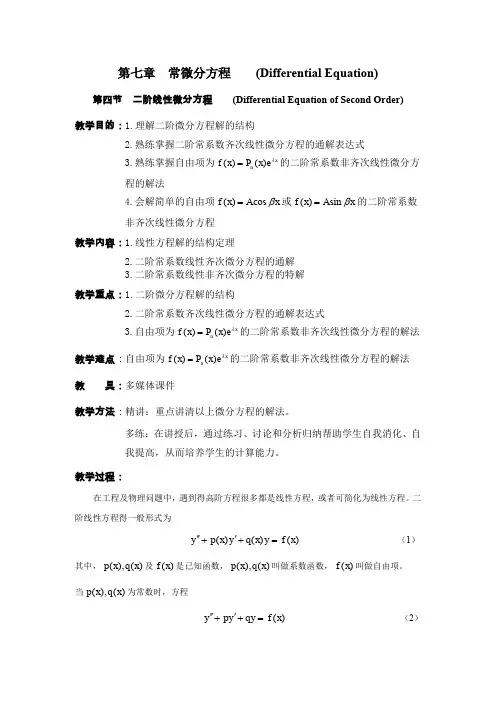
第七章 常微分方程 (Differential Equation)第四节 二阶线性微分方程 (Differential Equation of Second Order) 教学目的:1.理解二阶微分方程解的结构2.熟练掌握二阶常系数齐次线性微分方程的通解表达式3.熟练掌握自由项为()()x n f x P x e λ=的二阶常系数非齐次线性微分方 程的解法4.会解简单的自由项()cos f x A x β=或()sin f x A x β=的二阶常系数 非齐次线性微分方程教学内容:1.线性方程解的结构定理2.二阶常系数线性齐次微分方程的通解3.二阶常系数线性非齐次微分方程的特解教学重点:1.二阶微分方程解的结构2.二阶常系数齐次线性微分方程的通解表达式3.自由项为()()x n f x P x e λ=的二阶常系数非齐次线性微分方程的解法 教学难点:自由项为()()x n f x P x e λ=的二阶常系数非齐次线性微分方程的解法 教 具:多媒体课件教学方法:精讲:重点讲清以上微分方程的解法。
多练:在讲授后,通过练习、讨论和分析归纳帮助学生自我消化、自我提高,从而培养学生的计算能力。
教学过程:在工程及物理问题中,遇到得高阶方程很多都是线性方程,或者可简化为线性方程。
二阶线性方程得一般形式为 )()()(x f y x q y x p y =+'+'' (1)其中,)(),(x q x p 及)(x f 是已知函数,)(),(x q x p 叫做系数函数,)(x f 叫做自由项。
当)(),(x q x p 为常数时,方程)(x f qy y p y =+'+'' (2)叫做二阶常系数线性微分方程。
一、线性方程解的结构定理以上所述二阶线性微分方程得解得结构定理,是以常系数线性微分方程(2)为例,其所有结论,对方程(1)都成立。
在方程(2)中,若0)(≡x f ,则方程0=+'+''qy y p y (3)叫做二阶常系数线性齐次微分方程,相应的0)(≠x f 时,方程(2)叫做二阶常系数线性非齐次微分方程。
